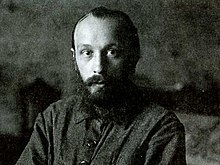
Rabelais and His World (Russian: Творчество Франсуа Рабле и народная культура средневековья и Ренессанса, Tvorčestvo Fransua Rable i narodnaja kul'tura srednevekov'ja i Renessansa; 1965) is a scholarly work by the 20th century Russian philosopher and literary critic Mikhail Bakhtin. It is considered to be a classic of Renaissance studies, and an important work in literary studies and cultural interpretation.
The book explores the cultural ethos of the Middle Ages and Renaissance as depicted by the French Renaissance writer François Rabelais, particularly in his novel Gargantua and Pantagruel.[1] Bakhtin argues that for centuries Rabelais's work has been misunderstood. He attempts to redress this and clarify Rabelais's intentions through recovery of sections of Gargantua and Pantagruel that were previously either ignored or suppressed, and analysis of the Renaissance social system in order to discover the balance between language that was permitted and language that was not. Bakhtin identifies two important subtexts: carnival, which he describes as a social institution, and grotesque realism, which he defines as a literary mode. Rabelais and His World examines the interaction between the social and the literary, as well as the meaning of the body.[2]
- ^ Clark, Katerina. (1984). Mikhail Bakhtin. Holquist, Michael, 1935-2016. Cambridge, Mass.: Belknap Press of Harvard University Press. pp. 295. ISBN 0-674-57416-8. OCLC 10727282.
- ^ Clark and Holquist 297-299